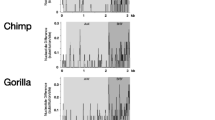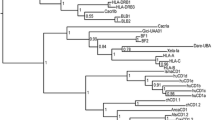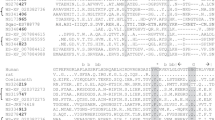Abstract
The CD33-related sialic acid binding Ig-like lectins (CD33rSiglecs) are predominantly inhibitory receptors expressed on leukocytes. They are distinguishable from conserved Siglecs, such as Sialoadhesin and MAG, by their rapid evolution. A comparison of the CD33rSiglec gene cluster in different mammalian species showed that it can be divided into subclusters, A and B. The two subclusters, inverted in relation to each other, each encode a set of CD33rSiglec genes arranged head-to-tail. Two regions of strong correspondence provided evidence for a large-scale inverse duplication, encompassing the framework CEACAM-18 (CE18) and ATPBD3 (ATB3) genes that seeded the mammalian CD33rSiglec cluster. Phylogenetic analysis was consistent with the predicted inversion. Rodents appear to have undergone wholesale loss of CD33rSiglec genes after the inverse duplication. In contrast, CD33rSiglecs expanded in primates and many are now pseudogenes with features consistent with activating receptors. In contrast to mammals, the fish CD33rSiglecs clusters show no evidence of an inverse duplication. They display greater variation in cluster size and structure than mammals. The close arrangement of other Siglecs and CD33rSiglecs in fish is consistent with a common ancestral region for Siglecs. Expansion of mammalian CD33rSiglecs appears to have followed a large inverse duplication of a smaller primordial cluster over 180 million years ago, prior to eutherian/marsupial divergence. Inverse duplications in general could potentially have a stabilizing effect in maintaining the size and structure of large gene clusters, facilitating the rapid evolution of immune gene families.










Similar content being viewed by others
Abbreviations
- IgV:
-
Immunoglobulin superfamily variable domain
- ITAM:
-
Immunoreceptor tyrosine-based activation motif
- ITIM:
-
Immunoreceptor tyrosine-based inhibition motif
References
Allcock RJ, Barrow AD, Forbes S, Beck S, Trowsdale J (2003) The human TREM gene cluster at 6p21.1 encodes both activating and inhibitory single IgV domain receptors and includes NKp44. Eur J Immunol 33:567–577. doi:10.1002/immu.200310033
Angata T (2006) Molecular diversity and evolution of the Siglec family of cell-surface lectins. Mol Divers 10:555–566. doi:10.1007/s11030-006-9029-1
Angata T, Marqulies EH, Green ED, Varki A (2004) Large-scale sequencing of the CD33-related Siglec gene cluster in five mammalian species reveals rapid evolution by multiple mechanisms. Proc Natl Acad Sci USA 101:13251–13256. doi:10.1073/pnas.0404833101
Angata T, Tabuchi M, Nakamura K, Nakamura M (2007) Siglec-15: an immune system Siglec conserved throughout vertebrate evolution. Glycobiology 17:838–846. doi:10.1093/glycob/cwm049
Angata T, Hayakawa T, Yamanaka M, Varki A, Nakamura M (2006) Discovery of Siglec-14, a novel sialic acid receptor undergoing concerted evolution with Siglec-5 in primates. FASEB J 20:1964–1973. doi:10.1096/fj.06-5800com
Barrow AD, Trowsdale J (2006) You say ITAM and I say ITIM, let's call the whole thing off: the ambiguity of immunoreceptor signalling. Eur J Immunol 36:1646–1653. doi:10.1002/eji.200636195
Belov K, Hellman L, Cooper DW (2002) Characterisation of echidna IgM provides insights into the time of divergence of extant mammals. Dev Comp Immunol 26:831–839. doi:10.1016/S0145-305X(02) 00030-7
Blasius AL (2006) Siglec-H is an IPC-specific receptor that modulates type I IFN secretion through DAP12. Blood 107:2474–2476. doi:10.1182/blood-2005-09-3746
Brinkman-Van der Linden EC, Hurtado-Ziola N, Hayakawa T, Wiggleton L, Benirschke K, Varki A, Varki N (2007) Human-specific expression of Siglec-6 in the placenta. Glycobiology 17:922–931. doi:10.1093/glycob/cwm065
Cao H, Lakner U, de Bono B, Traherne JA, Trowsdale J, Barrow AD (2008) SIGLEC16 encodes a DAP12-associated receptor expressed in macrophages that evolved from its inhibitory counterpart SIGLEC11 and has functional and non-functional alleles in humans. Eur J Immunol 38:2303–2315. doi:10.1002/eji.200738078
Crocker PR, Paulson JC, Varki A (2007) Siglecs and their roles in the immune system. Nat Rev Immunol 7:255–266. doi:10.1038/nri2056
Eizirik E, Murphy WJ, Springer MS, O’Brien SJ (2004) Molecular phylogeny and dating of early primate divergences. In: Kay R, Ross C (eds) Anthropoid origins. New Visions, Kluwer/Plenum, pp 45–64
Futcher AB (1986) Copy number amplification of the 2 micron circle plasmid of Saccharomyces cerevisiae. J Theor Biol 119:197–204
Harduin-Lepers A, Recchi MA, Delannoy P (1995) 1994, the year of sialyltransferases. Glycobiology 5:741–758. doi:10.1093/glycob/5.8.741
Hayakawa T, Angata T, Lewis AL, Mikkelsen TS, Varki NM, Varki A (2005) A human-specific gene in microglia. Science 309:1693
Holmgren J, Lönnroth I, Månsson J, Svennerholm L (1975) Interaction of cholera toxin and membrane GM1 ganglioside of small intestine. Proc Natl Acad Sci USA 72:2520–2524. doi:10.1073/pnas.72.7.2520
Hood L, Campbell JH, Elgin SC (1975) The organization, expression, and evolution of antibody genes and other multigene families. Annu Rev Genet 9:305–353. doi:10.1146/annurev.ge.09.120175.001513
Hubbard TJ, Aken BL, Beal K et al. (57 co-authors) (2007) Ensembl 2007. Nucleic Acids Res 35(Database issue):D610–D617. doi:10.1093/nar/gkl996
Hyrien O, Debatisse M, Buttin G, de Saint Vincent BR (1986) The multicopy appearance of a large inverted duplication and the sequence at the inversion joint suggest a new model for gene amplification. EMBO J 7:407–417
Kasahara M (2007) The 2R hypothesis: an update. Curr Opin Immunol 19:547–552. doi:10.1016/j.coi.2007.07.009
Klein J, O'hUigin C (1993) Composite origin of major histocompatibility complex genes. Curr Opin Genet Dev 3:923–930. doi:10.1016/0959-437X(93) 90015-H
Klein J, Sato A, O'hUigin C (1998) Evolution by gene duplication in the major histocompatibility complex. Cytogenet Cell Genet 80:123–127. doi:10.1159/000014967
Kuroda R, Satoh J, Yamamura T, Anezaki T, Terada T, Yamazaki K, Obi T, Mizoguchi K (2007) A novel compound heterozygous mutation in the DAP12 gene in a patient with Nasu–Hakola disease. J Neurol Sci 252:88–91. doi:10.1016/j.jns.2006.09.019
Liu GE, Matukumalli LK, Sonstegard TS, Shade LL, Van Tassell CP (2006) Genomic divergences among cattle, dog and human estimated from large-scale alignments of genomic sequences. BMC Genomics 7:140. doi:10.1186/1471-2164-7-140
Martin MP, Gao X, Lee JH et al (2002) Epistatic interaction between KIR3DS1 and HLA-B delays the progression to AIDS. Nat Genet 31:429–434
Nguyen DH, Hurtado-Ziola N, Gagneux P, Varki A (2006) Loss of Siglec expression of T lymphocytes during human evolution. Proc Natl Acad Sci USA 103:7765–7770. doi:10.1073/pnas.0510484103
Norman PJ, Parham P (2005) Complex interactions: the immunogenetics of human leukocyte antigen and killer cell immunoglobulin-like receptors. Semin Hematol 42:65–75. doi:10.1053/j.seminhematol.2005.01.007
Passananti C, Davies B, Ford M, Fried M (1987) Structure of an inverted duplication formed as a first step in a gene amplification event: implications for a model of gene amplification. EMBO J 6:1697–1703
Suzuki Y (2005) Sialobiology of influenza: molecular mechanism of host range variation of influenza viruses. Biol Pharm Bull 28:399–408. doi:10.1248/bpb.28.399
Tomasello E, Vivier E (2005) KARAP/DAP12/TYROBP: three names and a multiplicity of biological functions. Eur J Immunol 35:1670–1677. doi:10.1002/eji.200425932
Vanderheijden N, Delputte PL, Favoreel HW, Vandekerckhove J, Van Damme J, van Woensel PA, Nauwynck HJ (2003) Involvement of Sialoadhesin in entry of porcine reproductive and respiratory syndrome virus into porcine alveolar macrophages. J Virol 77:8207–8215. doi:10.1128/JVI.77.15.8207-8215.2003
Varki A (2006) Nothing in glycobiology makes sense, except in the light of evolution. Cell 126:841–845. doi:10.1016/j.cell.2006.08.022
Varki A (2007) Glycan-based interactions involving vertebrate sialic-acid-recognizing proteins. Nature 446:1023–1029. doi:10.1038/nature05816
Varki A, Angata T (2006) Siglecs—the major subfamily of I-type lectins. Glycobiology 16:1R–27R. doi:10.1093/glycob/cwj008
Varki A, Cummings R, Esko J, Freeze H, Hart G, Marth J (1999) Essentials of glycobiology. Cold Spring Harbor Laboratory Press, New York
Vimr E, Lichtensteiger C (2002) To sialylate, or not to sialylate: that is the question. Trends Microbiol 10:254–257. doi:10.1016/S0966-842X(02) 02361-2
Volz A, Wende H, Laun K, Ziegler A (2001) Genesis of the ILT/LIR/MIR clusters within the human leukocyte receptor complex. Immunol Rev 181:39–51. doi:10.1034/j.1600-065X.2001.1810103.x
Woodburne MO, Rich TH, Springer MS (2003) The evolution of tribospheny and the antiquity of mammalian clades. Mol Phylogenet Evol 28:360–385. doi:10.1016/S1055-7903(03) 00113-1
Yamanoue Y, Miya M, Inoue JG, Matsuura K, Nishida M (2006) The mitochondrial genome of spotted green pufferfish Tetraodon nigroviridis (Teleostei: Tetraodontiformes) and divergence time estimation among model organisms in fishes. Genes Genet Syst 81:29–39. doi:10.1266/ggs.81.29
Zhang J, Raper A, Sugita N, Hingorani R, Salio M, Palmowski MJ, Cerundolo V, Crocker PR (2006) Characterization of Siglec-H as a novel endocytic receptor expressed on murine plasmacytoid dendritic cell precursors. Blood 107:3600–3608. doi:10.1182/blood-2005-09-3842
Acknowledgments
We thank Professor Paul Crocker and Ajit Varki for critical reading of the manuscript and helpful comments.
Author information
Authors and Affiliations
Corresponding authors
Electronic supplementary material
Below is the link to the electronic supplementary material.
Fig. S1
Siglec EnsEMBL gene and protein ID. EnsEMBL gene and protein ID as well as chromosome/group/scaffold number are listed for genes described. Versions of the published assemblies used are included in the last page (DOC 29 kb)
Fig. S2
Human CD33rSiglec gene cluster 2D dot-plot analysis. Sequence of the whole human CD33rSiglec gene cluster is plotted on both x and y axes. For abbreviations and gene annotations, see Fig. 1. The diagonal line shows one-to-one correspondence between sequences on the x and y axes. Additional lines indicate regions of similarity between the two sequences. Perpendicular lines indicated regions likely created by an inverse duplication whereas parallel lines show regions likely created by tandem duplication. Perpendicular lines corresponding to CD33rSiglec genes form two distinct sets as shown by the circles (DOC 778 kb)
Fig. S3
Rhesus versus dog CD33rSiglec gene cluster dot-plot analysis. Sequence corresponding to the whole rhesus macaque CD33rSiglec gene cluster (x-axis) is plotted against that of the dog CD33rSiglec gene cluster (y-axis). For abbreviations and gene annotations, see Fig. 1. Perpendicular lines (PL1 and PL2) like those found in Fig. 2a, b that appear on one side of the fragmented diagonal lines and correspond to the rhesus subcluster B and the dog subcluster A. PL1 corresponds to Siglec-13 and CE18 in rhesus macaque subcluster B and the Siglec-9, -P3 and CE18 in the dog subcluster A. PL2 corresponds to the conserved ATB3 of the dog subcluster A and an unannotated region between rhesus macaque’s ZNF175 and Siglec-5 (DOC 592 kb)
Rights and permissions
About this article
Cite this article
Cao, H., de Bono, B., Belov, K. et al. Comparative genomics indicates the mammalian CD33rSiglec locus evolved by an ancient large-scale inverse duplication and suggests all Siglecs share a common ancestral region. Immunogenetics 61, 401–417 (2009). https://doi.org/10.1007/s00251-009-0372-0
Received:
Accepted:
Published:
Issue Date:
DOI: https://doi.org/10.1007/s00251-009-0372-0




